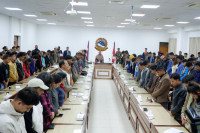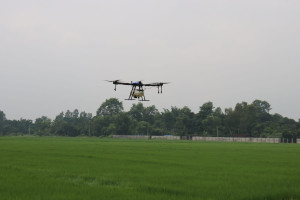Columns
Nepal’s NGO sector at a crossroads
Organisations governed with clarity and accountability and built for resilience will thrive in the future.
Dipendra KC
In the three decades since Nepal’s democratic transition, civil society has grown from a scattered network of community efforts into a dense and diverse ecosystem of non-governmental organisations (NGOs), community-based organisations and emerging social enterprises. From supporting Dalit communities in the Tarai to advocating for indigenous land rights in the hills, NGOs have played a vital role in plugging the gaps left by the state and market.
However, this sector is at a dangerous crossroads today, facing public scepticism, shrinking foreign aid, internal capacity constraints and a rapidly changing regulatory and political environment. The question is no longer whether NGOs are necessary. They are. The real question is whether they are equipped—in structure, leadership and legitimacy—to remain credible and relevant in a future where old models of funding and organising no longer apply.
Based on my research and work within this sector, I believe that without a renewed focus on strategic leadership, Nepal’s NGO community risks drifting into irrelevance—or worse, becoming a convenient scapegoat for deeper systemic failures.
Margins to mainstream and then stagnation
Nepal’s NGO boom wasn’t accidental—it was a direct outcome of the democratic opening in the 1990s, a period marked by expanded civic space, a surge in foreign aid and a nationwide push for public participation. This global “associational revolution” took firm root in Nepal, where the number of registered NGOs exploded from a few hundred in 1990 to over 22,000 in 2000 and surpassed 54,000 by 2025. Today, the country is home to more than 100,000 formal and informal civil society organisations (CSOs).
This growth wasn’t merely quantitative. Civil society has played a pivotal role at critical junctures—from the armed conflict to post-earthquake relief, the Covid-19 pandemic, and numerous local development initiatives. Some NGO professionals and local government officials estimate that as many as 60–70 percent of local elected leaders have formal experience working with NGOs, highlighting the sector’s deep influence on public leadership.
But that growth masked several structural weaknesses that threaten the sector’s sustainability.
‘Dollar harvester’ myth
One persistent and damaging misconception about NGOs is that they are flush with foreign cash—so much so that they’re viewed as ‘dollar harvesters’. But data tell a different story. NGOs and international NGOs combined received just 14 percent of Nepal’s total foreign aid in 2021. The government received 86 percent.
In a typical year, only one in 10 active NGOs receive direct foreign funding. The vast majority operate on shoestring budgets, surviving from one short-term project to the next. Despite this, the public continues to conflate visibility with wealth and foreign funding with foreign agendas—feeding a narrative that erodes trust and delegitimises the sector.
Geography of growth
Another issue is geographic imbalance. Contrary to the ideal of reaching the most marginalised, NGOs tend to cluster in areas that are already better resourced. In my study of where NGOs and social enterprises emerge, the strongest predictor was not the need but the existing density of organisations.
This pattern, seen across NGOs and social enterprises alike, reinforces structural inequities. Poorer, conflict-affected or geographically remote districts remain underserved—not because the problems aren’t urgent but because the incentives to operate there are weak. This is where strategic leadership, not just technical management, is required to reset organisational priorities and push beyond the comfort zones of Kathmandu-centric programming.
Moreover, the pandemic exposed just how brittle many NGOs really are. Nearly 14 percent shut down during Covid-19, but most survived—a testament to the sector’s resilience. Still, the deeper issues remain: Most NGOs are small, under-resourced and poorly staffed. They struggle to attract and retain talent. Graduates don’t see them as viable long-term career options. Leadership transitions are often informal, boards are symbolic, and too many organisations operate with minimal investment in systems, people, or governance.
Worse still, only 17 percent of the NGOs say their international partners actively invest in their organisational capacity. Donors and INGOs still treat local civil society organisations more as project implementers than true institutional partners. This failure to invest in the long-term health of organisations has created a cycle of dependency, mistrust and stagnation.
Structural shift
Perhaps the clearest signal of the sector’s transformation is the rise of profit-not-distributing companies (PNDCs)—mission-driven entities registered under company law. Between 2017 and 2021, the number of newly registered NGOs fell by 11 percent, while PNDCs grew by 15 percent. This is because the NGO regulatory environment is increasingly restrictive and politically risky, while company registration offers greater flexibility, access to finance and operational freedom. What we’re witnessing is not the collapse of civil society but its fragmentation into hybrid, less regulated forms. The problem is this shift also comes with risks—less transparency, more volatility and weaker social accountability.
Again, the need for strategic leadership is urgent—not only within NGOs, but across emerging organisational models. The challenge is not just to survive—but to build credible, accountable institutions that can adapt without abandoning their mission.
Innovation deficit
In my empirical study of 225 NGOs in Nepal, I found a clear link between effective board practices and innovation. Organisations whose boards were engaged in resource acquisition and monitoring were significantly more innovative across service delivery, administrative reform and governance processes.
Conversely, long board-chair tenures were negatively associated with innovation—suggesting that entrenchment and stagnation are real risks. Surprisingly, strategic involvement on paper had no significant impact—meaning it’s not what boards talk about that matters, but what they actually do.
This isn’t just a governance issue. It’s a leadership failure. We need boards that are engaged, diverse and performance-driven, not ceremonial rubber stamps. We need leadership that can bridge the operational, political and strategic demands of today’s nonprofit environment.
Reimagining NGOs’ future
As Nepal moves toward graduating from the least developed country status by 2026, aid will decline further. Civil society can’t afford to rely on foreign grants as its mainstay. Instead, we must explore remittance-based giving, local philanthropy and earned revenue models that align with mission without compromising values. This will require more than creative fundraising—it needs bold, strategic leadership capable of building public trust, navigating political risks and managing increasingly complex organisations with credibility and competence.
Civil society is not in decline—it is in transition. The organisations that thrive in the coming decade will not be those with the biggest donor portfolios or the slickest branding. They will be the ones that are led with clarity, governed with accountability and built for resilience. The age of autopilot NGO growth is over. What comes next depends on whether we take strategic leadership seriously—or continue to treat it as an afterthought.




 19.12°C Kathmandu
19.12°C Kathmandu















